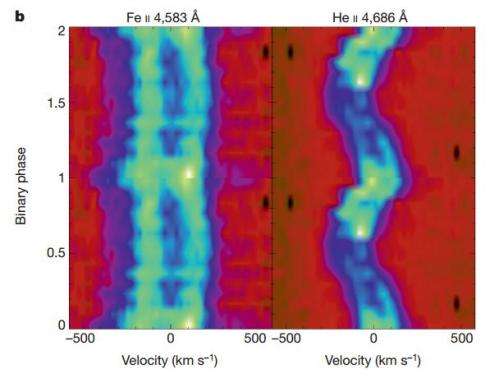January 16, 2014 report
Black hole that doesn't emit x-rays discovered near massive star

(Phys.org) —Researchers in Spain have discovered a black hole that doesn't reveal itself through x-ray radiation thrown off by material that is being sucked into it. In their paper published in the journal Nature, team members from several research institutions throughout Spain, report that the black hole appears to exist as a companion (binary) to a massive Be star that spins so fast it's surrounded by a gas disk.
Up until now, virtually all black holes have been discovered via x-ray radiation signals—as material is pulled in past the point of no return, radiation is flung out into space where it is noted by space scientists here on Earth. In this new effort, the research team was able to identify the black hole because of its behavior, rather than its signature.
Many Be stars have been found to have companions—most of the time they are supernova remnants (neutron stars) but never before has a Be star been found to have a black hole as a companion. The star, named MWC 656 is really big—approximately 10 to 16 times as massive as our sun. It spins really fast too (approximately 671,000 mph) which the researchers say, explains why the black hole next to it doesn't emit any radiation. They suggest that because the star is spinning so fast, it casts gas into a disk surrounding its equator which in turn is cast off towards the black hole, but rather than being pulled in, the gas joins an accretion disk that surrounds the "mouth" of the black hole, moving so fast (due to the angular momentum of the gas cast off from the star) that it can't be pulled in. Thus the disk simply continues to grow larger.
The black hole is pretty big too (approximately 3.8 to 6.9 more massive than our sun) which likely puts it in the category of stellar mass black holes—those that come into existence when a star runs out of fuel.
The discovery of the "silent" black hole suggests that many more like it might exist, which will undoubtedly lead researchers to look for more, now that they know what to look for.
More information: A Be-type star with a black-hole companion, Nature 505, 378–381 (16 January 2014) DOI: 10.1038/nature12916
Abstract
Stellar-mass black holes have all been discovered through X-ray emission, which arises from the accretion of gas from their binary companions (this gas is either stripped from low-mass stars or supplied as winds from massive ones). Binary evolution models also predict the existence of black holes accreting from the equatorial envelope of rapidly spinning Be-type stars (stars of the Be type are hot blue irregular variables showing characteristic spectral emission lines of hydrogen). Of the approximately 80 Be X-ray binaries known in the Galaxy, however, only pulsating neutron stars have been found as companions. A black hole was formally allowed as a solution for the companion to the Be star MWC 656 ( also known as HD 215227), although that conclusion was based on a single radial velocity curve of the Be star, a mistaken spectral classification6 and rough estimates of the inclination angle. Here we report observations of an accretion disk line mirroring the orbit of MWC 656. This, together with an improved radial velocity curve of the Be star through fitting sharp Fe II profiles from the equatorial disk, and a refined Be classification (to that of a B1.5–B2 III star), indicates that a black hole of 3.8 to 6.9 solar masses orbits MWC 656, the candidate counterpart of the γ-ray source AGL J2241+4454 (refs 5, 6). The black hole is X-ray quiescent and fed by a radiatively inefficient accretion flow giving a luminosity less than 1.6 × 10−7 times the Eddington luminosity. This implies that Be binaries with black-hole companions are difficult to detect in conventional X-ray surveys.
Journal information: Nature
© 2014 Phys.org


















